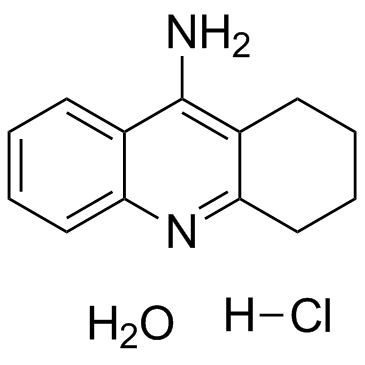206658-92-6
| Name | 1,2,3,4-Tetrahydro-9-acridinamine hydrochloride hydrate |
|---|---|
| Synonyms |
1,2,3,4-Tetrahydroacridin-9-amine hydrochloride hydrate
1,2,3,4-Tetrahydro-9-acridinamine hydrochloride hydrate 9-Acridinamine, 1,2,3,4-tetrahydro-, hydrochloride, hydrate (1:1:1) Tacrine hydrochloride hydrate |
| Description | Tacrine hydrochloride hydrate is an inhibitor of both acetyl (AChE) and butyryl-cholinestrase (BChE) with IC50s of 31 nM and 25.6 nM, respectively. |
|---|---|
| Related Catalog | |
| Target |
IC50: 31 nM (AChE), 25.6 nM (BChE) |
| In Vitro | Tacrine hydrochloride hydrate (12.5 to 37.5 nM) inhibits venom acetylcholinesterase as well as human serum butyrylcholinesterase in a concentration-dependent manner. The IC50 is 31 nM for snake venom AChE and 25.6 nM for human BChE[1]. |
| In Vivo | Pretreatment with Tacrine hydrochloride hydrate also modifies absolute levels of cocaine self-administration during reacquisition. Body weight declines approximately one-half percent over four days of treatment with intravenous Tacrine hydrochloride hydrate. Delivery of Tacrine hydrochloride hydrate by osmotic pump does not alter either linear- or repeated- cocaine-induced locomotor activity. There is no significant main effect or interaction with Tacrine hydrochloride hydrate treatment on active lever responding during reinstatement. Post hoc comparisons indicate that rats self-administering cocaine has significantly lower alkaline phosphatase levels, relative to Tacrine hydrochloride hydrate- but not saline- treated rats evaluated by conditioned-place preference[2]. |
| Kinase Assay | The kinetic parameters of the interaction between Tacrine hydrochloride hydrate and cholinesterase are determined using the double reciprocal plot analyzed over a range of acetylthiocholine concentrations (0.05 to 1 mM) in the absence and in the presence of Tacrine hydrochloride hydrate (12.5 to 37.5 nM). IC50 is determined by percentage residual activity versus concentration of Tacrine hydrochloride hydrate[1]. |
| Animal Admin | Male Wistar rats at 9 weeks of age are used in this study. As soon as rats exhibit a stable pattern of self-administration under fixed-ratio-5 (FR-5) with a 20-second time out, sessions are discontinued over 24 hours and rats are left undisturbed in home cages, attached to a fluid swivel and steel-coil tether. This initial washout interval is assessed as more than adequate to allow clearance of plasma cocaine, which has a half-life of less than 20 minutes in rats. Beginning on the following day, 10 mg/kg-day of Tacrine hydrochloride hydrate or vehicle (saline) is administered as a chronic infusion over 4 days, delivered intravenously at 4.0 ml per day. After completion of these infusions, rats are then left undisturbed in home cages for an additional two days. This second washout period permits complete clearance of Tacrine hydrochloride hydrate, which has a half-life of less than two hours in rat brain. Cocaine self-administration is then re-initiated under FR-5 with a 20-second time-out period. To determine persistent effects of Tacrine hydrochloride hydrate, the pattern of self-administration is monitored over six additional sessions[2]. |
| References |
| Molecular Formula | C13H17ClN2O |
|---|---|
| Molecular Weight | 252.740 |
| Exact Mass | 252.102936 |
| Storage condition | -20℃ |
| Symbol |


GHS06, GHS08 |
|---|---|
| Signal Word | Danger |
| Hazard Statements | H301-H311-H315-H319-H331-H335-H351 |
| Precautionary Statements | P261-P280-P301 + P310-P305 + P351 + P338-P311 |
| RIDADR | UN 2811 6.1 / PGIII |
